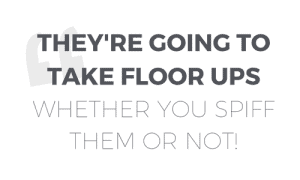This week, Alan Ram talks about the conflicts he sees at many dealerships and the simples steps managers can take to resolve them.
In our heads, we know what we want our people to be doing on a daily basis, but our actions and processes (or lack thereof) contradict what our heads are thinking and we end up sending our staff conflicting messages.
What do you see as you walk through your showroom? Many of you might see five salespeople standing out on the point for three hours waiting for one customer. As a dealer, that should make you crazy. What do you want to see? You want to see your people working the phones EFFECTIVELY and driving better quality traffic to the dealership. 
Here’s the Main Issues in Many Dealerships
First and foremost is your open floor. There is absolutely no benefit to you as a dealer in having an open floor. NONE!! All an open floor does is encourage your people to stand around and do nothing but wait for a floor-up that was coming in anyway.
I see this happen all the time. A dealership completes my training and their people are excited to work the phones. Then, a couple of salespeople think it’s not part of their job to actually follow up or generate anything. So, they continue to stand out on the lot and wait. They don’t have to compete anymore for floor traffic because all the other salespeople are doing what you want them to do on the phones.
Let’s say that one of these salespeople standing around just happens to bump into a customer that buys a car. Pretty soon, the salespeople that are on the telephone, start realizing that they are losing their chance to even get an up. As a result, human nature takes over and they start the migration back to the front door.
They indirectly feel that they are being punished by doing what you asked them to do. You’re open floor is hurting productivity and it needs to go.
Are You Rewarding the Wrong Behavior?
Have you ever had to bribe your kids to get them to eat their candy and ice cream? “Now Billy, if you don’t eat your ice cream, you’re not going to get any candy.” I doubt that’s a conversation that happens at anyone’s house. It’s more like “If you don’t eat your Brussel sprouts, you don’t get dessert”.
You don’t need to convince them to eat their candy and ice cream. They were going to eat that any way. Spiffing your salespeople for selling your floor-ups is the same thing.
They’re going to take your floor-ups whether you spiff them or not!
Let’s Compare
If a salesperson that sold 25 cars strictly off floor-ups was to leave tomorrow, how many deals would you lose? Probably none. Why? Because those customers would still come in. They would just be distributed differently. But, what about that salesperson that sells 20 cars a month from their own repeat and referral clients? If that salesperson was to leave, how many deals would you lose? I would say all of them.
A salesperson that sells repeat and referral customers is far more valuable to you than one that sells floor-ups.
If you’re going to have a spiff program, let’s spiff them for what you want them to do versus what they were going to do anyway! A referral spiff for example. If it really is a referral your salesperson that has generated through their efforts, wouldn’t it make sense to spiff them for that?
Change the Incentive
We all want our sales staff doing a better job at working (mining) their sold customer base. What if we spiff them for selling to their repeat customers or for turning service customers back into sales clients.
Now you have your salespeople thinking “I make more money by selling a repeat or referral clients than I do for floor-ups.”
That’s when they’ll start focusing on those things you want them to focus on. That’s when you’re using your spiff money to change their behavior and ultimately change the culture. You will not sell one less car by eliminating a unit bonus. But you WILL sell a lot more cars by instituting a repeat and referral spiff.
And it all starts with….
Training. It might seem obvious but, it really is the key to all of this coming together and getting the results you want. Your people need to be trained on how to get results on the phone. It gives them confidence. When they have confidence they’re much more likely to be successful and gain momentum.
It all starts with training and having processes in place that are consistent with, and not in conflict with, what you want to see happening on your showroom floor.



